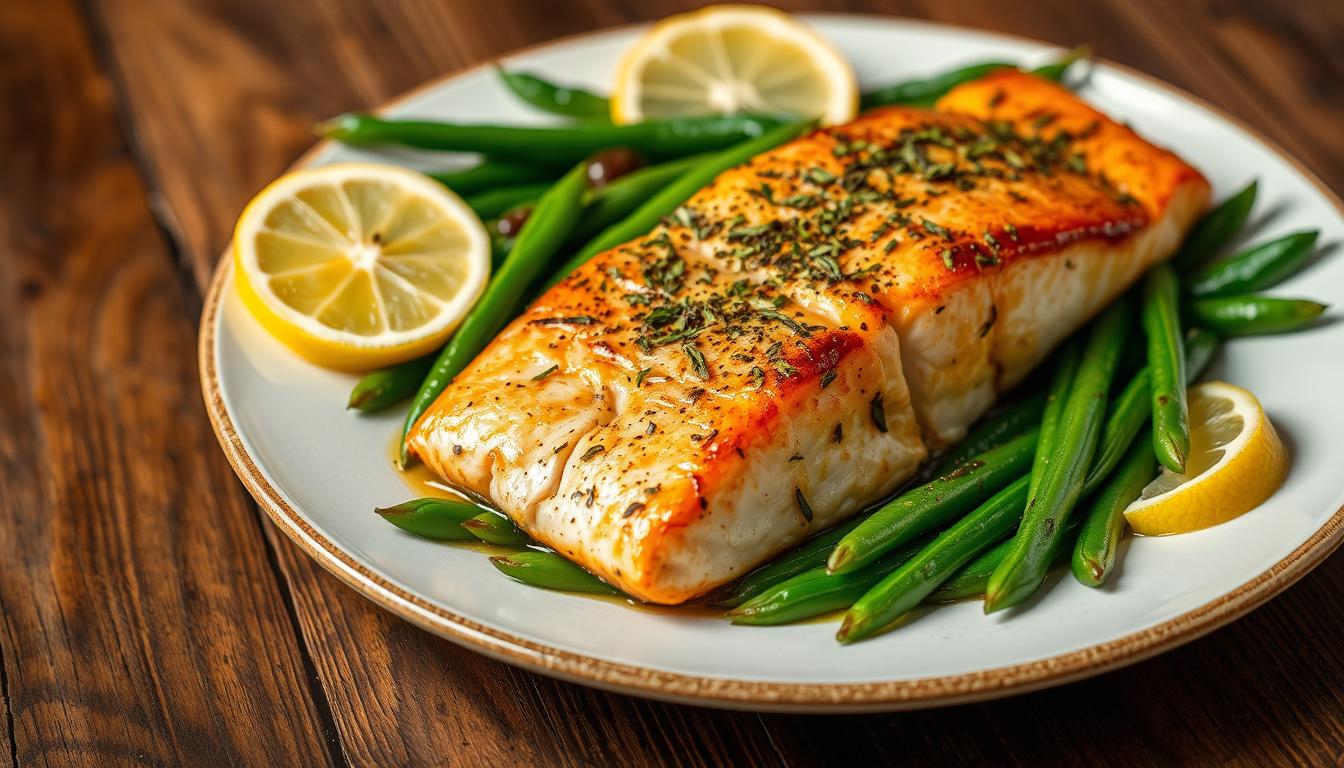Do you suffer from fibromyalgia? You’re not alone. A recent study found that 6 percent of women in the US have this chronic condition. But, there’s a tasty and healthy way to manage your pain and fatigue. Our Roasted Salmon with Green Beans is perfect for those with fibromyalgia.
This recipe is full of anti-inflammatory omega-3 fatty acids. It’s a big help in managing fibromyalgia symptoms. Plus, research shows that over 50% of fibromyalgia patients find dietary changes very helpful.
So, why wait? Try this delicious dish and start your journey to better health. Enjoy the flavors of the sea and the goodness of greens. All while nourishing your body and easing your fibromyalgia-related pain.
What is Fibromyalgia?
Fibromyalgia is a long-term condition that causes widespread pain, tenderness, and fatigue. It also affects memory. About 3.7 million Americans have it, mostly middle-aged women. People with fibromyalgia face many challenges, including:
- Widespread, chronic pain
- Extreme fatigue and lack of energy
- Difficulty concentrating and memory problems
- Sleep disturbances
- Mood changes, such as depression and anxiety
The exact reasons for fibromyalgia are not known. It’s thought to be caused by genetics, brain issues, and environmental factors. These factors may make pain worse and cause other symptoms. Scientists are working hard to find the causes and treatments for this chronic pain disorder.
| Symptom | Description |
|---|---|
| Widespread Pain | People with fibromyalgia have constant pain all over their body. This includes muscles, joints, and soft tissues. |
| Fatigue | Fibromyalgia patients often feel extremely tired. They get tired even after sleeping a lot. |
| Memory Issues | Many with fibromyalgia have trouble remembering things. They also find it hard to focus and think clearly, known as “fibro fog.” |
There’s no cure for fibromyalgia yet. But, doctors can help manage symptoms with medicine, lifestyle changes, and other treatments. This can make life better for those with this chronic pain disorder.
Dietary Approaches for Fibromyalgia
There’s no single diet to cure fibromyalgia, but making dietary changes can help. Eating anti-inflammatory, nutrient-rich foods and avoiding triggers can improve your life. This can make a big difference in managing your symptoms.
Embracing an Anti-Inflammatory Diet
Studies show that a mix of treatments can help with fibromyalgia. An anti-inflammatory diet, full of whole foods, is often suggested. It’s part of a broader approach to managing symptoms.
- Eat foods rich in omega-3s like salmon, sardines, flaxseeds, and walnuts to fight inflammation.
- Choose fruits and veggies that are full of antioxidants, like green leafy greens and berries.
- Add spices like turmeric, ginger, and cinnamon to your meals for their anti-inflammatory effects.
- Go for grass-fed, organic meats and dairy to avoid additives and hormones.
Following an anti-inflammatory diet for 1-3 months can help reduce inflammation and fight fatigue in fibromyalgia patients.
Identifying and Avoiding Trigger Foods
Some foods, like those with MSG, aspartame, gluten, and processed ingredients, can make symptoms worse. Keeping a food diary can help you find out which foods trigger your symptoms. This way, you can make better food choices.
- Try to limit or avoid processed foods, artificial sweeteners, caffeine, and dairy to see if they help your symptoms.
- Consider a low-FODMAP diet, which can help with pain and weight management for some.
- Stick to whole foods like veggies, fruits, lean proteins, and gluten-free grains for better health and symptom control.
By making smart dietary choices and eating anti-inflammatory, nutrient-rich foods, you can manage your fibromyalgia symptoms better. This can greatly improve your quality of life.
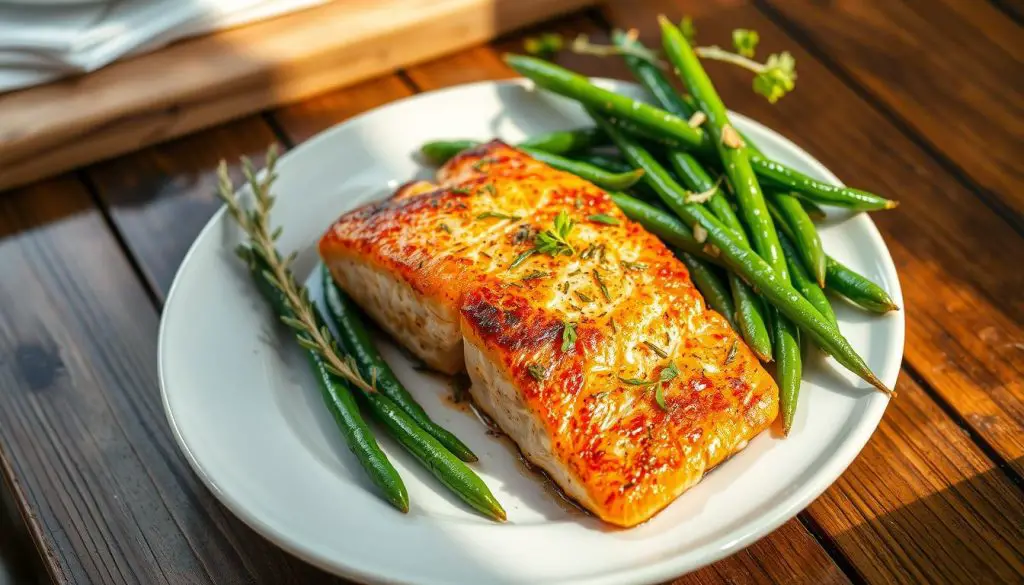
Roasted Salmon with Green Beans for Fibromyalgia
Living with fibromyalgia can make finding good food tough. But, roasted salmon with green beans is a great choice. It’s not only tasty but also helps with fibromyalgia symptoms.
Salmon is full of omega-3 fatty acids. These fats are great for fighting inflammation. They can help with the pain and stiffness that fibromyalgia causes. Plus, salmon has lots of vitamin D, which is good for bones and the immune system.
Adding green beans to your salmon makes the meal even better. Green beans are packed with vitamins and antioxidants. They help keep you healthy and might even ease fibromyalgia symptoms.
Adding roasted salmon with green beans for fibromyalgia to your meals is a smart move. It’s a way to take care of your body and manage your condition.
Benefits of Salmon for Fibromyalgia
If you have fibromyalgia, adding salmon to your meals can make a big difference. Salmon is full of omega-3 fatty acids. These fats are great at fighting inflammation and easing joint pain, helping you feel better.
A 2019 study in the Annals of Medicine showed that diet changes helped fibromyalgia patients. They slept better, felt less anxious, and enjoyed a better life. A 2016 study also found that eating foods rich in antioxidants helped those with fibromyalgia. They had fewer painful spots and felt better overall.
Salmon’s Nutritional Benefits
Salmon is not just packed with omega-3 fatty acids. It also has other nutrients that help with fibromyalgia, like:
- Vitamin B12, which helps with tiredness and brain fog
- Magnesium, which supports muscles and reduces pain
- Antioxidants, which fight stress and inflammation
Eating salmon and other nutrient-rich foods can help manage fibromyalgia symptoms. It can also improve your overall health.
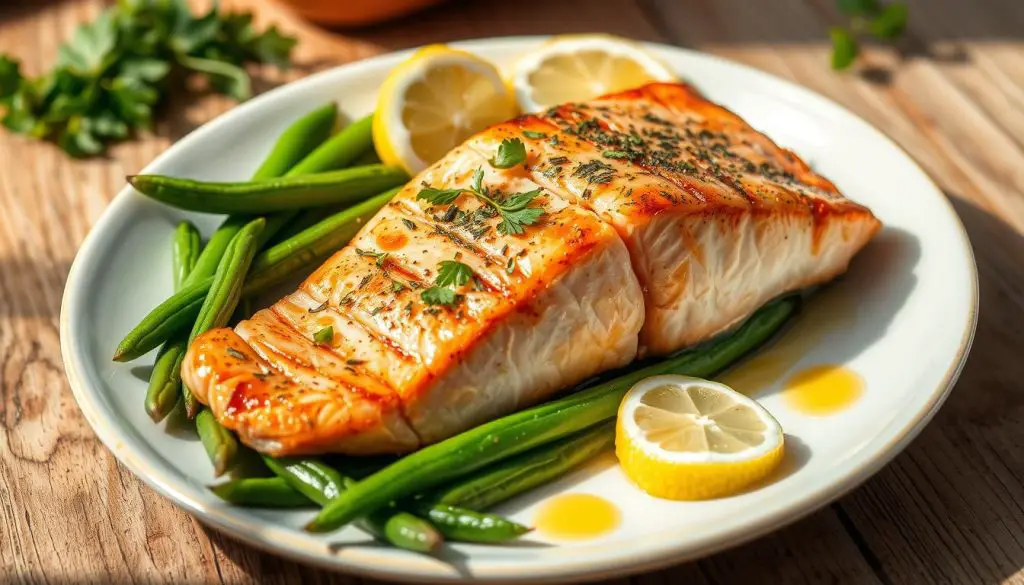
Remember, eating a balanced diet with foods like salmon is key to managing fibromyalgia. Talk to your doctor to create a diet plan that fits your needs.
Importance of Vitamin D
People with fibromyalgia might have a higher risk of vitamin D deficiency. This can lead to muscle weakness and bone pain. Eating foods rich in vitamin D, like salmon, can help fix this problem and ease fibromyalgia symptoms.
Vitamin D is key for strong muscles and bones. Research shows that those with fibromyalgia often have less vitamin D. This lack can make muscle weakness and bone pain worse.
| Vitamin D-Rich Foods | Vitamin D Content (per serving) |
|---|---|
| Salmon, cooked | 447 IU (11.2 mcg) |
| Egg yolks | 44 IU (1.1 mcg) |
| Fortified milk | 120 IU (3 mcg) |
| Fortified orange juice | 100 IU (2.5 mcg) |
| Tuna, canned | 154 IU (3.9 mcg) |
Eating more vitamin D-rich foods can help your body stay healthy. It might also reduce symptoms like muscle weakness and bone pain in fibromyalgia. Talk to your doctor to see if you need more vitamin D and how to get it.
Anti-Inflammatory Spice Mix
For those with fibromyalgia, adding an anti-inflammatory spice mix to your meals can be a big help. This mix of turmeric, ginger, cinnamon, and crushed red chili peppers is great for fighting inflammation and easing joint pain.
Turmeric is known for its strong anti-inflammatory powers. Ginger helps with pain and stiffness. Cinnamon adds warmth and also fights inflammation. The chili peppers bring heat, which can help circulation and metabolism.
Research shows that about 2-4 teaspoons of quality spice mix per day can be very helpful. The Anti-Inflammatory Spice Mix recipe makes about 1-1/2 cups, enough for 20 servings. It’s simple to add to your meals and snacks.
You can use it on roasted veggies, in oatmeal, or on salmon. This blend can help reduce inflammation and ease fibromyalgia symptoms.
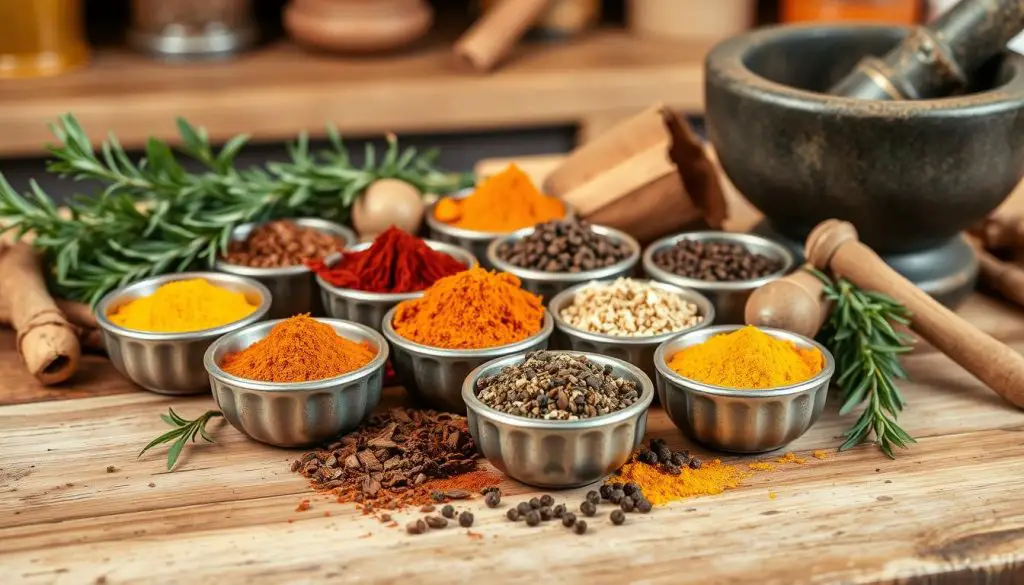
Adding anti-inflammatory foods like berries, leafy greens, and fatty fish is also good for you. By choosing the right foods, you can manage your fibromyalgia better and live a better life.
Green Beans: A Nutritious Side Dish
Incorporating nutritious side dishes like green beans can help manage fibromyalgia symptoms. Green beans are a fibromyalgia-friendly option. They are rich in vitamins, minerals, and antioxidants that boost your health.
Green beans are full of vitamin C, vitamin K, and manganese. These nutrients help reduce inflammation and support your immune system. They also have a lot of fiber, which can help with digestion and ease stomach issues common in fibromyalgia patients.
- Green beans are a versatile nutritious side dish that can be prepared in many ways, like roasting or steaming.
- They go well with roasted salmon, making a balanced and fibromyalgia-friendly meal.
- Adding more green beans to your diet can help manage fibromyalgia symptoms and support your health.
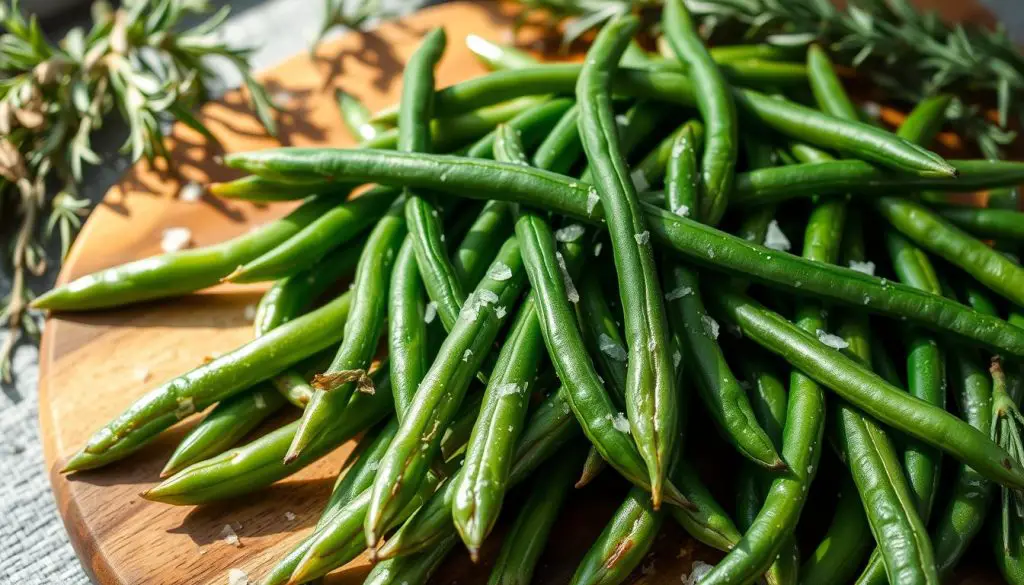
Looking to add more nutritious side dishes to your meals or ease fibromyalgia symptoms? Green beans are a great choice for your fibromyalgia-friendly diet.
Avoiding Potent Triggers
For those with fibromyalgia, adding anti-inflammatory and nutrient-rich foods is key. But, it’s also vital to watch out for trigger foods that can make symptoms worse. Foods like caffeine, processed foods, and artificial sweeteners should be cut down or avoided. This is part of a diet that’s good for fibromyalgia.
Caffeine and Processed Foods
Caffeine in coffee, tea, and snacks can be a big trigger food for fibromyalgia sufferers. Too much caffeine can make pain, fatigue, and sleep issues worse. Processed foods also have additives and lots of sodium. These can cause inflammation and make fibromyalgia symptoms worse.
Artificial Sweeteners
Artificial sweeteners like aspartame and MSG are also trigger foods for fibromyalgia. Studies show avoiding these can cut symptoms by 30% in people with fibromyalgia and IBS. Symptoms come back when these additives are eaten again.
By knowing and avoiding these fibromyalgia trigger foods, you can help manage your condition. This can greatly improve your health and well-being.
The Importance of a Food Diary
Keeping a detailed food diary is key for those with fibromyalgia. It helps track what you eat and how it affects your symptoms. This way, you can find out which foods might be causing problems.
A food diary lets you watch how your diet affects your fibromyalgia symptoms. It’s great for spotting foods that make your pain or fatigue worse. By noting what you eat and how you feel, you can find patterns. This helps you make better food choices.
Using a food diary to track symptoms can also show if diet changes help. As you try new foods and meal plans, the diary shows what works best. This helps you find a diet that’s right for you.
A food diary also helps you see if you’re getting all the nutrients you need. It’s a way to make sure you’re eating well. This helps your body work better and manage your fibromyalgia.
Adding a food diary to your daily life is a big step in managing fibromyalgia. By keeping track of what you eat and how you feel, you can learn a lot. This knowledge can improve your life and help you manage your condition better.
Meal Planning and Preparation Tips
Effective meal planning and preparation are key for those with fibromyalgia. They often face energy and symptom challenges. Here are some tips to help you make healthy, fibromyalgia-friendly meals:
- Batch cook and meal prep: Spend time on weekends cooking big batches of meals. These can be reheated or assembled later in the week. It saves energy on busy days.
- Utilize simple, one-pot recipes: Choose dishes like roasted veggies, baked salmon, and slow-cooker stews. They’re easy to make and clean up, perfect for managing fibromyalgia.
- Embrace frozen and canned options: Frozen fruits and veggies, and canned fish and beans, are nutritious and easy to use in meals.
- Plan for snacks: Have healthy snacks ready, like nuts, fresh fruit, or veggie sticks with hummus. They help keep your energy up.
Using these meal preparation tips can make eating healthy easier. It lets you focus on managing your fibromyalgia symptoms and staying well.
| Meal Planning Tip | Description |
|---|---|
| Batch Cooking | Prepare larger portions of healthy meals on the weekend to reheat or assemble throughout the week. |
| One-Pot Recipes | Opt for simple, easy-to-make dishes that require minimal hands-on time and cleanup, such as roasted vegetables or slow-cooker stews. |
| Frozen and Canned Ingredients | Utilize frozen fruits and vegetables, as well as canned fish and beans, for nutritious and convenient meal components. |
| Snack Preparation | Keep a variety of healthy, fibromyalgia-friendly snacks on hand to help maintain steady energy levels. |
Recipes for Roasted Salmon with Green Beans
Try our roasted salmon with green beans recipe for a fibromyalgia-friendly meal. It’s full of omega-3 fatty acids and anti-inflammatory spices. This dish is a tasty way to ease your symptoms.
Roasted Salmon with Green Beans
First, heat your oven to 375°F. Season the salmon with an anti-inflammatory spice mix. This mix includes turmeric, ginger, cinnamon, and crushed red chili peppers.
Put the salmon and green beans on a baking sheet. Drizzle with olive oil and roast for 18-22 minutes. Wait until the salmon is cooked and the beans are tender.
Add a lemon cilantro sauce for extra flavor. Mix lemon juice, garlic, cilantro, and olive oil. Pour the sauce over the salmon and green beans before you serve.
This recipe makes 4-6 servings and takes 40 minutes to prepare. It cooks for 20 minutes. Enjoy this meal packed with nutrients and anti-inflammatory properties to help with fibromyalgia symptoms.
| Ingredient | Quantity |
|---|---|
| Salmon fillets | 3-4 medium-sized |
| Green beans | 1.5 lbs |
| Lemon juice | 2 tablespoons |
| Garlic, minced | 2 cloves |
| Cilantro, chopped | 1/4 cup |
| Olive oil | 2 tablespoons |
Lifestyle Modifications for Fibromyalgia
Diet is key in managing fibromyalgia, but other lifestyle factors matter too. Regular exercise, stress management, and good sleep can help a lot. These changes can make a big difference in how you feel.
Doing low-impact exercises like walking, swimming, or gentle yoga can help. Regular exercise can lessen pain, fatigue, and depression. It’s good for your heart and mood too.
Stress management is also important. Techniques like meditation, deep breathing, or mindfulness can help. They reduce muscle tension, improve sleep, and bring calm.
Source Links
- http://ndl.ethernet.edu.et/bitstream/123456789/36842/1/3125.pdf
- https://livingwithfibromyalgia.org/fibromyalgia-friendly-recipes/
- https://www.canningandcookingiastyle.com/tag/paleo/page/2/
- https://www.everydayhealth.com/fibromyalgia/diet/fibromyalgia-what-eat-what-avoid/
- https://www.verywellhealth.com/fibromyalgia-diet-good-and-bad-foods-4144693
- https://universityhealthnews.com/daily/pain/fibromyalgia-diet-may-help-control-pain/
- https://www.myfibroteam.com/resources/the-simplicity-of-the-anti-inflammatory-diet-for-fibromyalgia
- https://www.healthline.com/nutrition/how-to-cook-salmon
- https://www.eatingwell.com/article/291150/fibromyalgia-diet-foods-you-should-eat-and-foods-you-should-avoid/
- https://www.verywellhealth.com/chronic-fatigue-syndrome-fibromyalgia-diet-715718
- https://www.healthline.com/health/fibromyalgia-diet-to-ease-symptoms
- https://ukfibromyalgia.com/blog/food-and-mood
- https://amyriolo.blogspot.com/2018/05/my-mediterranean-anti-inflammatory-meal.html
- https://www.realsimple.com/food-recipes/recipe-collections-favorites/best-anti-inflammatory-recipes
- https://www.medicalnewstoday.com/articles/323164
- https://www.healthline.com/nutrition/50-super-healthy-foods
- https://www.chantalhoeysanders.com/chpt-2-controlling-symptoms-with-fo
- https://www.eatingwell.com/article/7866119/rheumatoid-arthritis-diet-plan/
- https://www.medicalnewstoday.com/articles/315386
- https://healingworksfoundation.org/resource/guide-to-nutrition-for-chronic-pain-what-you-eat-can-make-a-difference/
- https://www.healthline.com/nutrition/leaky-gut-diet
- https://www.confrontingchronicpain.com/your-nutrition-plan-for-chronic-pain/
- https://nutritionsource.hsph.harvard.edu/healthy-weight/diet-reviews/anti-inflammatory-diet/
- https://www.healthline.com/health/crohns-disease/recipes
- https://www.healthline.com/nutrition/low-carb-diet-meal-plan-and-menu
- https://www.aol.com/see-white-stuff-salmon-means-123701504.html#!
- https://perfecthealthdiet.com/category/food/salmon-seafood/
